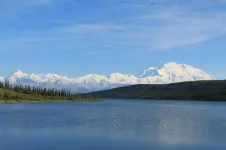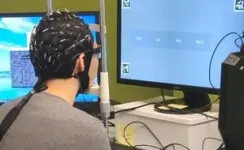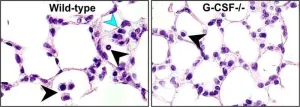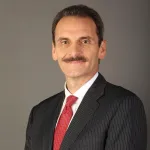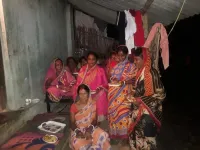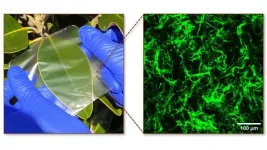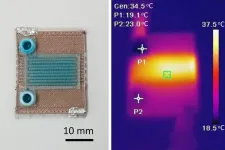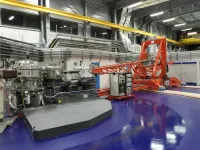(Press-News.org) URBANA, Ill. — Natural resource management decisions in protected areas impact more than the wildlife and landscapes they’re charged to conserve. They also affect neighbors, who could otherwise hunt, build, or recreate as they choose on their own land. For decades, community members primarily voiced their opinions through brief and impersonal public comment periods. But an initiative led by environmental social scientists at the University of Illinois Urbana-Champaign is putting a new spin on neighborly communication.
“Historically, public land management agencies would offer brief periods where people could submit a remark that may or may not be considered and that typically wouldn’t result in any meaningful dialogue,” said Carena van Riper, associate professor in the Department of Natural Resources and Environmental Sciences in the College of Agricultural, Consumer and Environmental Sciences (ACES) at U. of I. “For more inclusive conservation to happen, there needs to be in-depth engagement, communication, and deliberation with diverse stakeholders. There's real benefit to engaging people.”
Van Riper has been working toward a model of inclusive conservation for nearly a decade in the area surrounding Alaska’s Denali National Park, partnering with the National Park System (NPS) to examine the values and viewpoints of neighbors on everything from conservation priorities to tourism impacts. She and her colleagues published results of their latest engagement efforts in Sustainability Science.
The study brought Denali neighbors together in a month-long online discussion forum designed to understand their views on the benefits and threats facing the area, as well as how land management agencies could better incorporate their perspectives.
Van Riper noted that residents come from all walks of life and have priorities that span protected area conservation, indigenous use, tourism, energy development, and others.
“Although it is important, conservation is just one of many priorities,” she said. “We tried to equalize the power dynamic among interest groups and in how we framed the National Park Service and its role in defining life in Interior Alaska.”
Residents were grouped according to a values assessment, with two groups of like-minded participants and one group representing a mix of values. This allowed the research team to test whether the value-basis of decision-making affected the ways that people learned from one another and engaged in collaborative dialogue.
“I went into this project worried because a lot of online dialogue tends to be very combative. But the most wonderful discussions unfolded with this group of people; they were always thoughtful and respectful to one another. They disagreed, but we never had to step in and intervene,” said lead author Devin Goodson, a doctoral student working with van Riper. “Another one of the benefits of engaging online is people weren't forced to fully explain their thoughts in the moment, like you’d have to do during a short public comment session. The platform created a really well informed and constructive conversation.”
After a period where participants got to know each other during focus groups, they were engaged through the Denali Discussion Forum, where the researchers posed a series of questions about the park and its management. Residents were expected to answer the questions and interact with other participants’ answers on a weekly basis during the month-long program.
Goodson said the residents discussed many of the same benefits of living near Denali, though the groups differed in the emphasis they placed on particular benefits, which included access to wilderness, solitude, recreation, hunting and fishing grounds, and the pursuit of a subsistence lifestyle. Likewise, the groups emphasized slightly different threats, including tourism, competing interests, mismanagement, and climate change – the latter was mentioned only by the mixed values group, which comprised a younger demographic. The groups diverged more strongly in their discussions on management solutions.
“We found that residents value the Alaskan landscape in a lot of ways and often identify common threats, but they come up with different ways to solve these issues. However, a common thread across the proposed solutions for resource managers was that people just wanted to feel like they were a part of the process in a meaningful way,” Goodson said. “They're open to what that looks like, but they want to feel that the process overall is fair.”
Co-author William Stewart in the Department of Recreation, Sport and Tourism at U. of I. added, “The NPS makes well-intentioned decisions, yet sometimes, residents of nearby communities feel like their voices aren't being heard. They need help. Social scientists have a toolkit for that. We engage community residents not as decision-makers, but as outsiders who could represent community voices to help facilitate dialogue with the park, and within the park service.”
Armed with results from the Denali Discussion Forum, which were summarized weekly by the study team with input from participants, NPS can move ahead with more informed management decisions. And they can use a similar model to solicit input for future management actions.
But the lessons extend well beyond Denali and even the National Park System. Goodson said the study is an example of one way to give average people a say in the things that impact them every day in their environment.
“People care about their environment and they’re a lot more knowledgeable than they get credit for. This is one example of how people could communicate how they feel to resource managers and other community members in their area,” he said. “There's no reason to think our model can't be adapted elsewhere.”
The study, “Broad values as the basis for understanding deliberation about protected area management,” is published in Sustainability Science [DOI: 10.1007/s11625-023-01423-z]. Authors include Devin Goodson, Carena van Riper, Riley Andrade, William Stewart, Miguel Cebrian-Piqueras, and Christopher Raymond.
Funding for this research was provided by a Cooperative Agreement with the National Park Service (P18AC00175) and a project called ENVISION funded through the 2017–2018 Belmont Forum and BiodivERsA joint call for research proposals, under the BiodivScen ERA-Net COFUND program, and with the support of the following national funders: Swedish Research Council for Sustainable Development (FORMAS), Federal Ministry of Education and Research, Germany, Netherlands Organisation for Scientific Research (NWO), US National Science Foundation (Grant No. 1854767), and the Ministerio de Ciencia e Innovación, Spain (Grant PCI2018-092958 funded by MCIN/AEI/https://doi.org/10.13039/501100011033). The authors also thank the Wissenschaftskolleg zu Berlin and the Center of Advanced Study, German Federal Ministry of Education and Research (BMBF) (Grant No. 01LC18064), and the University of Illinois Campus Research Board (RB19119).
END
Alaskan allies: Communities unite to protect the areas they love
2023-12-11
ELSE PRESS RELEASES FROM THIS DATE:
Researchers find promising candidate to treat irreversible lung and eye diseases in extremely premature infants
2023-12-11
Philadelphia, December 11, 2023 – Advancements in the care of premature babies are leading to improved survival rates. However, the incidence of neonatal diseases with life-long consequences such as bronchopulmonary dysplasia (BPD) and retinopathy of prematurity (ROP) is increasing. A novel study has implicated granulocyte colony-stimulating factor (G-CSF) in both BPD and ROP, making it a promising therapeutic candidate. The results appear in The American Journal of Pathology, published by Elsevier.
BPD, also called chronic lung disease of immaturity, afflicts approximately one third of all extremely ...
Public bodies “overwhelmed” at having to implement human rights laws, study warns
2023-12-11
Statt at public bodies can be “overwhelmed” by having to implement human rights laws into the working of their organisation when staff are in “awe” of legislation, a new study warns.
When laws are viewed as sacrosanct control over interpretation and implementation can be seen as the responsibility of a privileged few, according to the research.
This leads to staff placing greater weight on implementation through processes. Laws are seen as so specialist staff feel they do not have the perceived required knowledge and expertise and cannot be trusted to implement them.
Those who see equality and human rights law as malleable believe they should ...
If a piece of Turkey gets stuck in your throat this Christmas, there is no point in trying to free it with Cola
2023-12-11
Cola. A drink forever associated with the Christmas season. And also, for many, a liquid that can help clear a blocked oesophagus. Something that may be a bit more likely at this time of year. However, research from Amsterdam UMC, published today in the BMJ Christmas Issue, shows that this is not worth wasting the sugary stuff.
"Emergency physician Elise Tiebie, the driving force behind this project, saw online that this was really a rumour, from tip websites to Wikipedia as well as an anecdote in a British newspaper about paramedics saving a life by using cola. I've even heard doctors recommending it,” says Arjan Bredenoord, Professor of Gastroenterology at ...
McGovern Medical School names new neurosurgery chair; Tandon takes on role at UTHealth Houston Neurosciences
2023-12-11
Jacques Morcos, MD, a renowned neurosurgeon from University of Miami Health System, will join UTHealth Houston as the new chair of the Vivian L. Smith Department of Neurosurgery with McGovern Medical School at UTHealth Houston, effective today.
Morcos will also serve as co-director of UTHealth Houston Neurosciences alongside Louise McCullough, MD, PhD, chair of the Department of Neurology, and will be appointed as the Nancy, Clive and Pierce Runnells Distinguished Chair in Neuroscience.
Nitin Tandon, MD, former chair ad interim of the neurosurgery department, ...
Study: Women-led groups were key to food security during COVID-19 in India
2023-12-11
In March of 2020, India’s government announced a strict lockdown with just four hours notice, including a ban on the informal and traditional food outlets that 80 to 90 percent of Indians rely on for their main source of food.
In a new paper, “Applying the six-dimensional food security framework to examine a fresh fruit and vegetable program implemented by self-help groups during the COVID-19 lockdown in India,” published in the journal World Development, researchers from the Alliance of Bioversity International and CIAT looked at the effects of a government-backed women’s self-help group program in the state of Odisha, India and how it impacted the six ...
Researchers combine biopolymers derived from the ocean to replace synthetic plastic films
2023-12-11
Materials with enhanced structure derived from crustaceans and seaweed could be part of a next-generation answer to the challenge of replacing petroleum-based plastic films, according to new research from North Carolina State University.
Combining chitosan, a biopolymer that makes crab shells hard, with agarose, a biopolymer extracted from seaweed that is used to make gels, creates unique biopolymer composite films with enhanced strength. The films are also biodegradable, have antibacterial properties, repel water and are transparent. The findings could eventually lead to sustainable packaging films for food ...
Scientists 3D print self-heating microfluidic devices
2023-12-11
MIT researchers have used 3D printing to produce self-heating microfluidic devices, demonstrating a technique which could someday be used to rapidly create cheap, yet accurate, tools to detect a host of diseases.
Microfluidics, miniaturized machines that manipulate fluids and facilitate chemical reactions, can be used to detect disease in tiny samples of blood or fluids. At-home test kits for Covid-19, for example, incorporate a simple type of microfluidic.
But many microfluidic applications require chemical reactions that must be performed at specific temperatures. These more complex microfluidic devices, which are typically manufactured in a clean ...
A cause for the "strange" behavior of cuprates discovered - a step towards more sustainable superconductor applications
2023-12-11
Milan, December 11, 2023 - Taking a significant step forward in superconductivity research, the discovery could pave the way for sustainable technologies and contribute to a more environmentally friendly future.
The study just published in Nature Communications by researchers from Politecnico di Milano, Chalmers University of Technology in Göteborg and Sapienza University of Rome sheds light on one of the many mysteries of high-critical-temperature copper-based superconductors: even at temperatures above the critical temperature, they are special, behaving like "strange" metals. This means that their electrical resistance ...
Know Diabetes by Heart™ collaborative awards funding for community education
2023-12-11
ARLINGTON, VA and DALLAS, December 11, 2023 — The American Diabetes Association® and the American Heart Association® have awarded grants to 10 community organizations to help people living with Type 2 diabetes lower their risk for cardiovascular diseases like heart attack, heart failure and stroke.
The community grants are part of the leading health non-profits’ joint Know Diabetes by Heart™ initiative which seeks to reduce cardiovascular events and deaths among people living with Type 2 diabetes. The grants will help organizations in California, Florida, Georgia, ...
Hodgkin lymphoma prognosis, biology tracked with circulating tumor DNA
2023-12-11
A Stanford Medicine-led, international study of hundreds of samples from patients with Hodgkin lymphoma has shown that levels of tumor DNA circulating in their blood can identify who is responding well to treatment and others who are likely to experience a disease recurrence — potentially letting some patients who are predicted to have favorable outcomes forgo lengthy treatment.
Surprisingly, the study also revealed that Hodgkin lymphoma, a cancer of the lymph nodes, can be divided into two groups, each with distinct genetic changes and slightly different prognoses. These changes hint ...
